The ecosystem of the Great Plains is in deep trouble from an invader, that invader just 100 years ago was a welcome sight to the prairies with no trees. Many fostered these invaders, planted them, nursed them along so they could get a foothold in a hostile environment. That invader is cedar trees.
First what constitutes the Great Plains.
This area covers parts of the U.S. states of Colorado, New Mexico, Texas, Oklahoma, Kansas, Nebraska, South Dakota, North Dakota, Montana, and Wyoming.
Sorry Iowa you’re not part of the Great Plains, you’re part of the Central Plains.
For the most part their is a hard line to the west - the Plains stops at the mountains. To the east its not such an abrubt transistion. Its more subtle and nuanced as we move east. Moisture ranges from 12 inches to 25 inches.
Since I live in Nebraska my feeling is once you get past Lincoln you start seeing changes in the landscape - the transition. Once you get to the Grand Island / Kearney area you are in the thick of it. If on the interstate you are going to see for the most part center pivot irrigation units, but in the distance you will see hills. The interstate follows the Platte ( Flat ) River. Get off the interstate and you will see scenery like no other and meet people like no others.
https://surprisingtravelfinds.com/2019/12/nebraska-route-2/
If you take Highway 2 West out of Grand Island you will see the Great Plains largely unchange with the exception of a pivot here and there. From Grand Island it meanders north and west up to Crawford Nebraska.
Further to the north the boundry moves to the east, along Highway 91, Boone County you will start to see a difference. If you follow Hwy 91 to Spaulding Nebraska to Hwy 281 you will see nearly every feature of the Nebraska Sandhills. Short choppy hills, blowouts, grass as far as the eye can see, a truly inspiring sight. You will seldom see houses, at corners you will see various ranched listed and how far it is to the ranch headquarters 2 miles,3 miles sometimes 5 miles or more. From there take 281 / 91 to Erikson and head west. You will truly be in for a beautiful sight you will never forget.
Back to the crux of this great invasion.
I am concentrating on Nebraska because that is where I live and have the most experience and data available.
The following link is a link where you can click on the county and the data for grass production loses and acreage coverage is covered. For the most part it covers 1990 to present. So in 33 years it reflects the invasion and lose of land to these invaders.
https://www.wlfw.org/yieldgap/Nebraska/Douglas/index.html
This link gives a great overview of Highway 2 through Nebraska
Very interesting county by county data on the damage to the environment these cedar trees and some other woodland species are doing. Without some serious work we will have a crisis on our hands very soon. Cedar trees especially are damaging pastures, on average a pasture with a cedar infestation looses around 2% to 10% of its production capabilities per year - yes it works just like compound interest. If you have 100 acres and the first year you loose 2% and compound that over 30 years you will have less than 20 acres of pasture left. in 35 years you will have nothing left.
If you take the drives above you will see this happening. I am seeing this in my own area where I live. Along roadsides these little pest are soon going to be big pest that bring all sorts of havoc.
To roads drifting with snow and more time to move it along with heavier equipment.
Change in the birds we see. We will see more predator birds and less prey birds. Trees give predators cover and the other birds avoid them and their will over all be less of them. In my area you would see quail semi regularly, now its a rare sight. Upland birds and trees do not mix. Upland birds like wide open spaces. In the Plains we are seeing less grouse and prairie chickens due to these cedar trees. These are birds that thrive in prairie - huge expanses of grass. Trees and these two upland birds will move on and die off. Their survival range lessened.
Road hazards. Yes these trees block line of sight, but even worse they give deer and other large animals a place to stay. This means their are more deer and vehicle crashes. The deer is killed nearly every time, cars are totaled nearly every time, humans and injured nearly every time and sometimes die in the collision.
Airport hazards. Yes I live nest to a small airport and these tree that grow around the airport will lead to events on the runway.
Crop land and pasture devastation. Pasture devastation is covered some what above, but these trees affect cropland also. They affect the the yields on everything. That is 156 square miles
Wild fires. This spring several large fires started around North Platte Nebraska. One burned through 100,000 acres before it was done. That is about the size of Denver CO. with 153 square miles. The below link has the square miles of many cities. Can you imagine a city the size of Denver burning down?
https://www.indexmundi.com/facts/united-states/quick-facts/cities/rank/land-area
Water and cedar trees.
The amount of water cedar trees use is phenomenal. 25-30 gallons per day per tree for those over 10 foot tall. As you can imagine that is a lot of water for a semi arid environment that recieves 15-20” of moisture per year.
My family has been fighting this tree since 2013 I can attest it is relentless, the cost to even hold your ground is tremendous, and to gain ground is even more expensive. We spent the better part of 7 years cutting and planning and we are going to need to burn again in 3-5 years. More on our fight against this invader in a future stack.
Solutions?
Well their are solutions but they are time and money consuming. Cutting them is the most expensive and time consuming of all and honestly the least effective.
Skid Steer, grapple, tree saw for skid steer, trailer for the skid steer, a heavy duty truck to pull everything then maintenance the time and effort running the machine. $30,000 -$50,000 is a start for set up with used equipment.
Controled burning.
Well you need all the above to clear out trees and pack them around large groves or canyon walls. However the time spent is certainly less than wholesale clearing with machine.
Burning will not clear every tree, their will be survivors, canyon walls are notorious for not catching fire. The fire goes 10-20 and extinguishes. The fire is so intense it can consume all the oxygen in these areas. The only way these walls get cleared is if a wind of 10-15 mph pushes the flames up the walls. This can lead to a wild fire as the rush of embers coming up over the edge is intense and the fire can go 50-60 feet high. pushing the embers hundreds or thousands of feet outside the fire boundries.
Fortunately here in Nebraska a farmer / landowner can burn on his / her own. The state encourages locals to form burn crews of residents, farmers, ranchers and land owners. These crews are free as labor is traded between them. Many states require trained, bonded and licensed crews. That can run to $100.00 or more per acre, and in some cases the burn bosses think the hazard is to great and will not even submit a bid. We had this happen to us. Our place is pretty wild and inaccessable with huge areas covered in trees. the professionals absolutely wanted nothing to do with it. We ended up through contacts we had made and helping on burns getting involved in other burns and when it was our turn all the locals showed up to help.
Our burn ended up being a planned 1300 acre burn, we had 1 breakout that burned an extra acre of ground. The professionals told us it would be a national fire where airsupport would be called in and national crews would be required if this place was started on fire. So I guess the farmers and ranchers know more than the professionals? I know they have far superior equipment and methods. More on that in a future stack.
I’ve included pictures of before, during and after the burn. It takes a special type of people to want to do this, do it correctly and sometimes literally possibly put their life on the line. Rugged individuals, independent individuals maybe a dying breed in the USA. But in the Nebraska sandhills their are still remnants of such people. Fire people are some of the best people you will ever meet. They enjoy a challenge, the like to have fun but can be serious when the need arises, even within a split second.
.
When the above area finally caught it was unlike any sound you have every heard. The crackles, pops, roaring fire when a groupd of trees burst into flames. It was intense, it was so hot several hundred feet away was nearly uncomfortable.
Enough for now I will have a couple more stacks on burns and equipment.



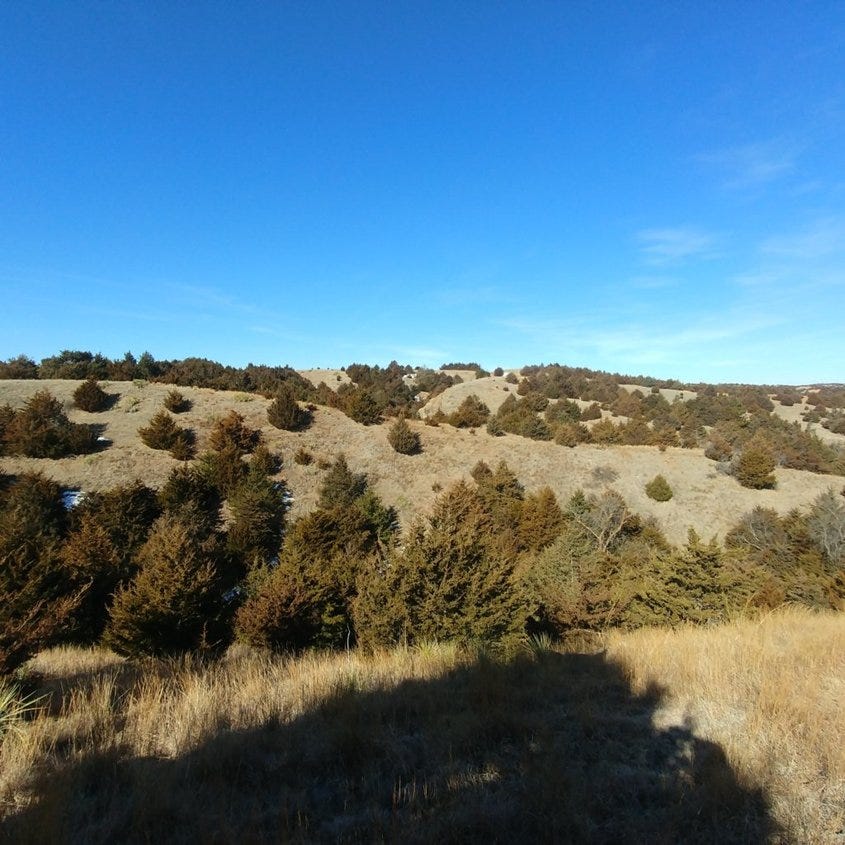

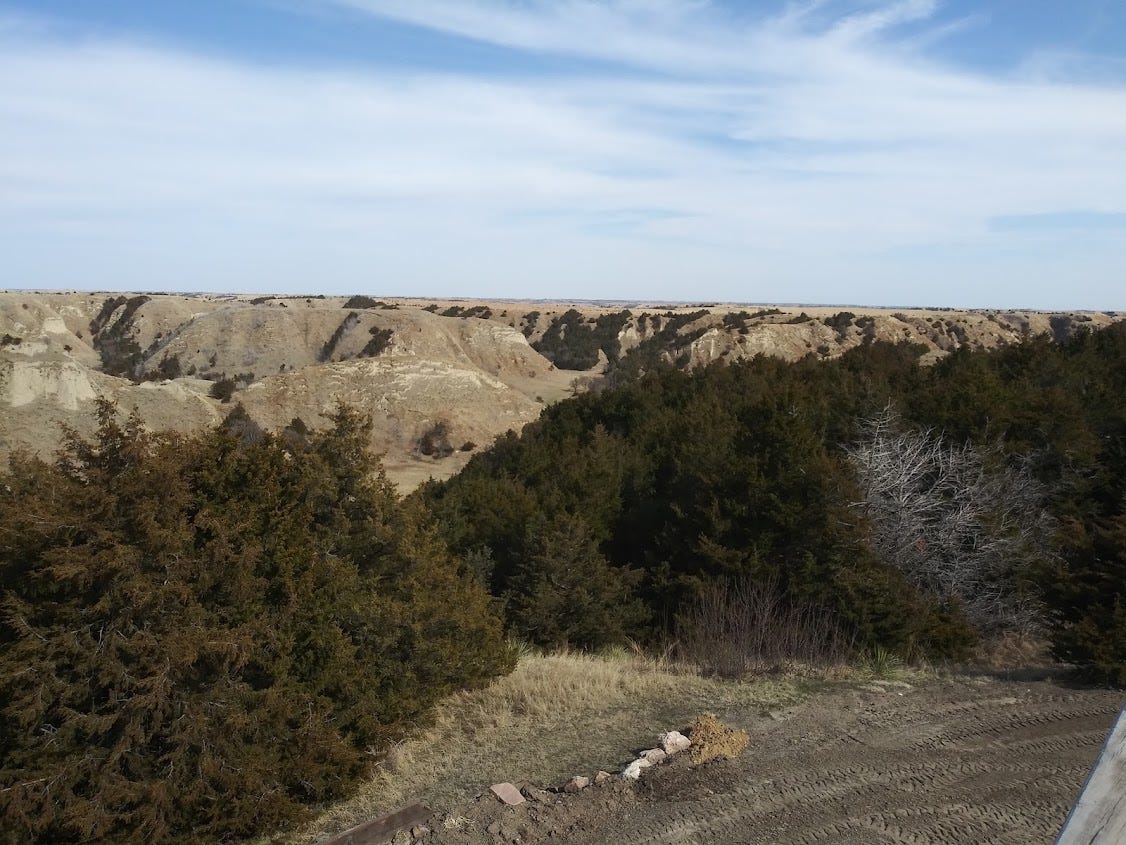

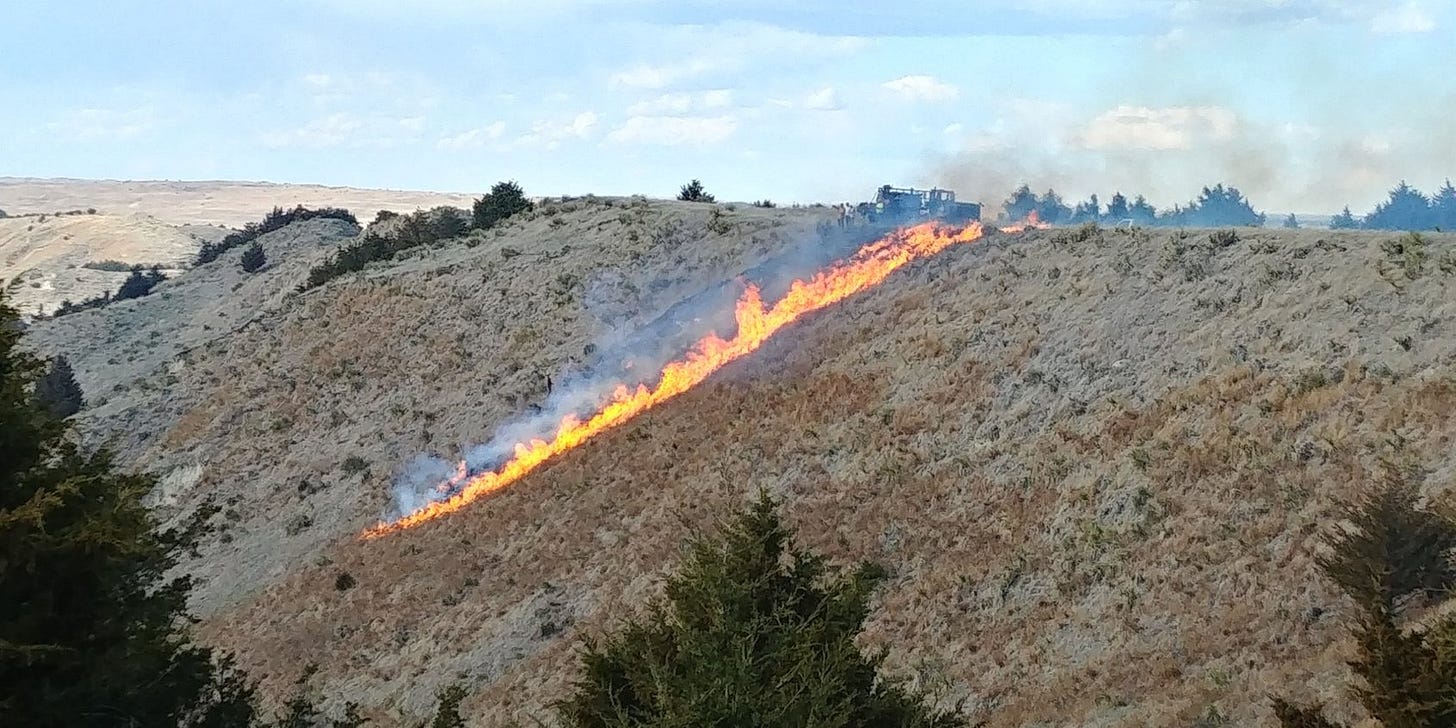



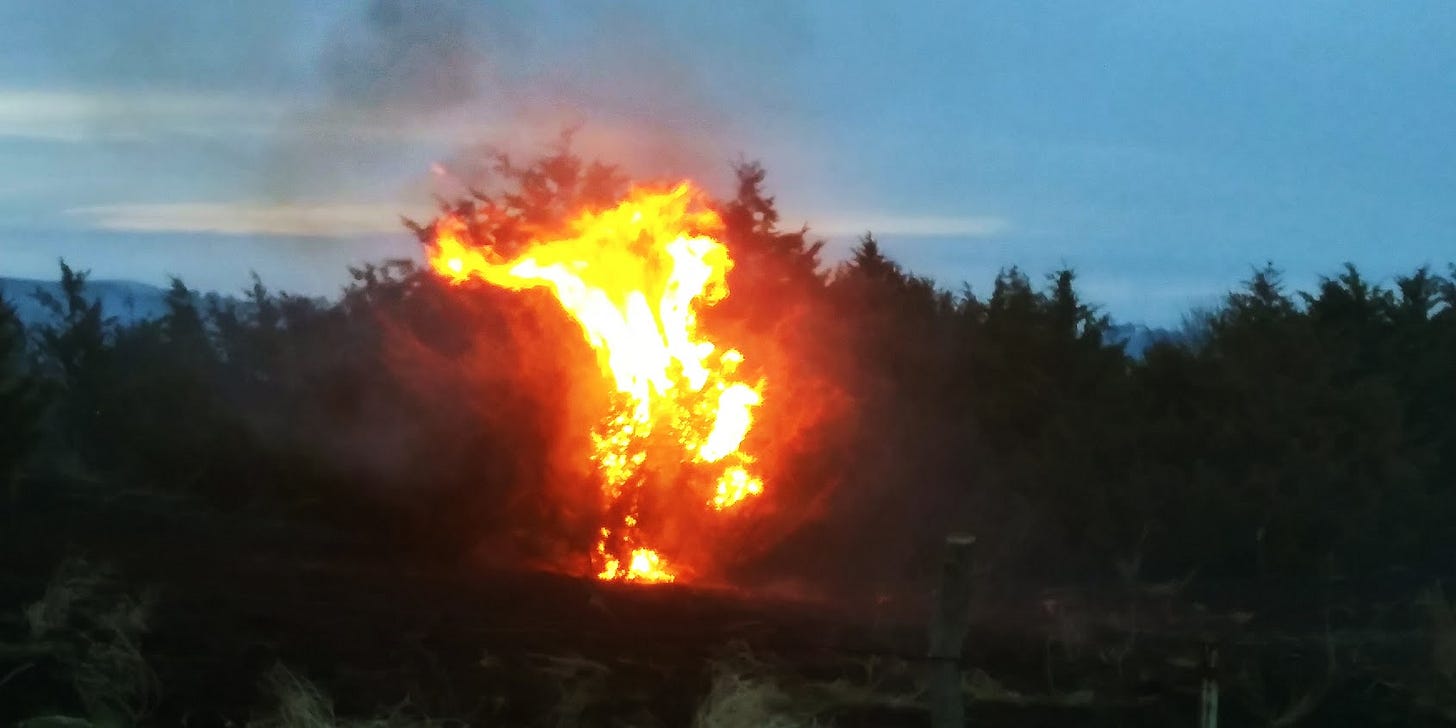


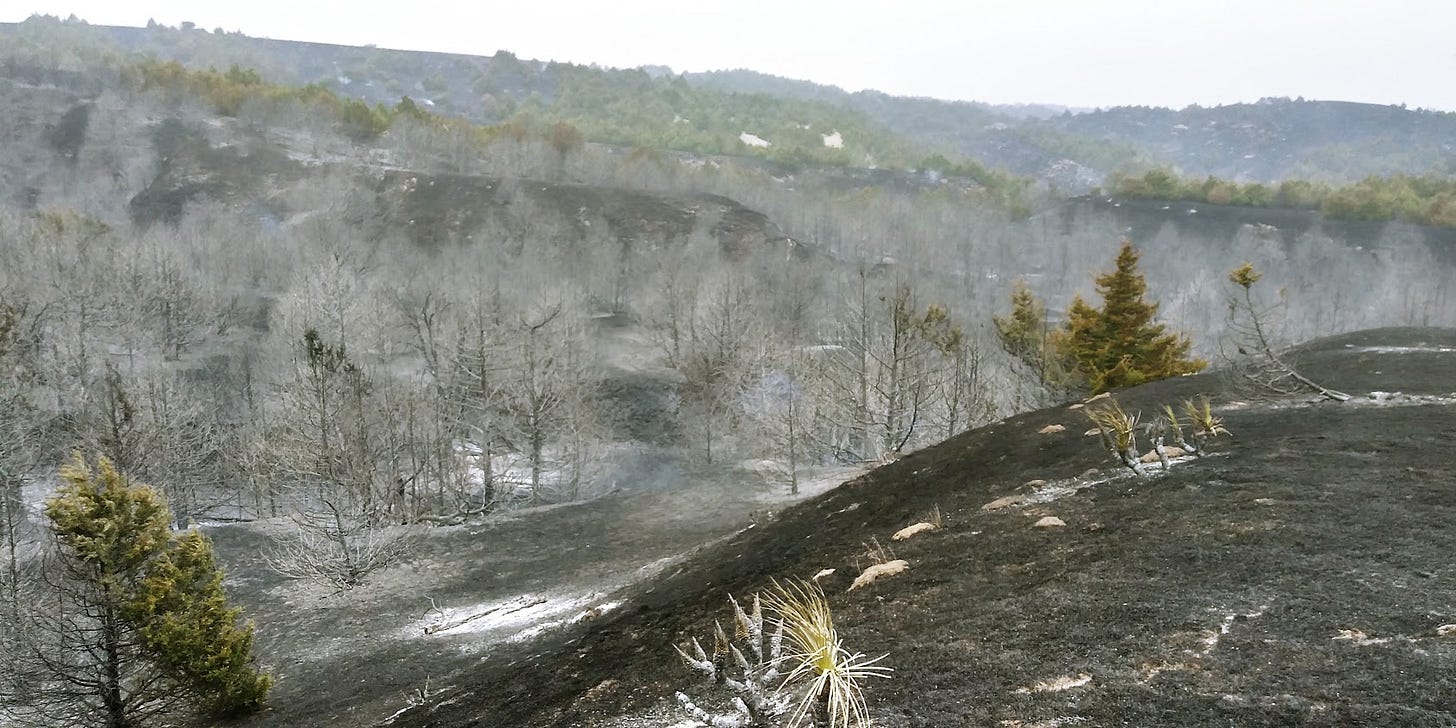

I was reading about buffalo, what they eat, and learned that they tend to destroy saplings, which protects the grasses they live on. Now I see why the Satanists killed all of the buffalo: they protected the plains and kept everything fertile and green.
I am so glad that someone is taking these nuisances out!
I can offer you a few more reasons to burn the cedars.
1. Ticks love cedars, because they're the right height to allow a tick to brush off on a deer or another large ruminant, and hitch a ride. The last thing we need is more ticks--and more tick-borne diseases.
2. Wildfires really love those cedars. The wildfires a few years ago absolutely devastated an entire area up on the rim of the Wyoming plateau in the panhandle (one of my uncles ranches in the top left corner). The fires were so bad because those cedars provided so much fuel. If the cedars hadn't been there (or in such numbers), the fires would have been a lot less damaging.